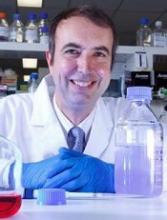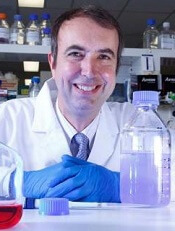User login
Researchers have used CRISPR-Cas9 gene editing to reproduce naturally occurring mutations that boost the production of fetal hemoglobin.
The mutations are associated with hereditary persistence of fetal hemoglobin (HPFH), and the researchers believe that introducing these mutations into erythroid cells could be a safe way to treat β-hemoglobinopathies such as sickle cell disease (SCD) and β-thalassemia.
This research was published in Nature Genetics.
“Our new approach can be seen as a forerunner to ‘organic gene therapy’ for a range of common inherited blood disorders, including β-thalassemia and sickle cell anemia,” said study author Merlin Crossley, DPhil, of the University of New South Wales in Sydney, Australia.
“It is organic because no new DNA is introduced into the cells; rather, we engineer in naturally occurring, benign mutations that are known to be beneficial to people with these conditions. It should prove to be a safe and effective therapy, although more research would be needed to scale the processes up into effective treatments.”
Dr Crossley and his colleagues noted that reactivating fetal hemoglobin production has long been a therapeutic goal for SCD and β-thalassemia.
“The fetal hemoglobin gene is naturally silenced after birth,” Dr Crossley explained. “For 50 years, researchers have been competing furiously to find out how it is switched off, so it can be turned back on. Our study, which is the culmination of many years of work, solves that mystery.”
“We have found that 2 genes, called BCL11A and ZBTB7A, switch off the fetal hemoglobin gene by binding directly to it. And the beneficial mutations work by disrupting the 2 sites where these 2 genes bind.”
The “beneficial mutations,” which cause some forms of HPFH, are point mutations in the γ-globin gene promoter at -115 and -200 bp upstream of the transcription start site.
Dr Crossley and his colleagues found that BCL11A31 and ZBTB7A23—2 well-established fetal globin repressors—bind these regions of the γ-globin gene proximal promoter, and mutations at –115 and –200 bp disrupt the binding.
The researchers used CRISPR-Cas9 to introduce the HPFH-associated mutations into erythroid cells and observed both disruption of repressor binding and increased γ-globin gene expression.
“This landmark finding not only contributes to our appreciation of how these globin genes are regulated,” Dr Crossley said. “It means we can now shift our focus to developing therapies for these genetic diseases using CRISPR to target precise changes in the genome.”
Researchers have used CRISPR-Cas9 gene editing to reproduce naturally occurring mutations that boost the production of fetal hemoglobin.
The mutations are associated with hereditary persistence of fetal hemoglobin (HPFH), and the researchers believe that introducing these mutations into erythroid cells could be a safe way to treat β-hemoglobinopathies such as sickle cell disease (SCD) and β-thalassemia.
This research was published in Nature Genetics.
“Our new approach can be seen as a forerunner to ‘organic gene therapy’ for a range of common inherited blood disorders, including β-thalassemia and sickle cell anemia,” said study author Merlin Crossley, DPhil, of the University of New South Wales in Sydney, Australia.
“It is organic because no new DNA is introduced into the cells; rather, we engineer in naturally occurring, benign mutations that are known to be beneficial to people with these conditions. It should prove to be a safe and effective therapy, although more research would be needed to scale the processes up into effective treatments.”
Dr Crossley and his colleagues noted that reactivating fetal hemoglobin production has long been a therapeutic goal for SCD and β-thalassemia.
“The fetal hemoglobin gene is naturally silenced after birth,” Dr Crossley explained. “For 50 years, researchers have been competing furiously to find out how it is switched off, so it can be turned back on. Our study, which is the culmination of many years of work, solves that mystery.”
“We have found that 2 genes, called BCL11A and ZBTB7A, switch off the fetal hemoglobin gene by binding directly to it. And the beneficial mutations work by disrupting the 2 sites where these 2 genes bind.”
The “beneficial mutations,” which cause some forms of HPFH, are point mutations in the γ-globin gene promoter at -115 and -200 bp upstream of the transcription start site.
Dr Crossley and his colleagues found that BCL11A31 and ZBTB7A23—2 well-established fetal globin repressors—bind these regions of the γ-globin gene proximal promoter, and mutations at –115 and –200 bp disrupt the binding.
The researchers used CRISPR-Cas9 to introduce the HPFH-associated mutations into erythroid cells and observed both disruption of repressor binding and increased γ-globin gene expression.
“This landmark finding not only contributes to our appreciation of how these globin genes are regulated,” Dr Crossley said. “It means we can now shift our focus to developing therapies for these genetic diseases using CRISPR to target precise changes in the genome.”
Researchers have used CRISPR-Cas9 gene editing to reproduce naturally occurring mutations that boost the production of fetal hemoglobin.
The mutations are associated with hereditary persistence of fetal hemoglobin (HPFH), and the researchers believe that introducing these mutations into erythroid cells could be a safe way to treat β-hemoglobinopathies such as sickle cell disease (SCD) and β-thalassemia.
This research was published in Nature Genetics.
“Our new approach can be seen as a forerunner to ‘organic gene therapy’ for a range of common inherited blood disorders, including β-thalassemia and sickle cell anemia,” said study author Merlin Crossley, DPhil, of the University of New South Wales in Sydney, Australia.
“It is organic because no new DNA is introduced into the cells; rather, we engineer in naturally occurring, benign mutations that are known to be beneficial to people with these conditions. It should prove to be a safe and effective therapy, although more research would be needed to scale the processes up into effective treatments.”
Dr Crossley and his colleagues noted that reactivating fetal hemoglobin production has long been a therapeutic goal for SCD and β-thalassemia.
“The fetal hemoglobin gene is naturally silenced after birth,” Dr Crossley explained. “For 50 years, researchers have been competing furiously to find out how it is switched off, so it can be turned back on. Our study, which is the culmination of many years of work, solves that mystery.”
“We have found that 2 genes, called BCL11A and ZBTB7A, switch off the fetal hemoglobin gene by binding directly to it. And the beneficial mutations work by disrupting the 2 sites where these 2 genes bind.”
The “beneficial mutations,” which cause some forms of HPFH, are point mutations in the γ-globin gene promoter at -115 and -200 bp upstream of the transcription start site.
Dr Crossley and his colleagues found that BCL11A31 and ZBTB7A23—2 well-established fetal globin repressors—bind these regions of the γ-globin gene proximal promoter, and mutations at –115 and –200 bp disrupt the binding.
The researchers used CRISPR-Cas9 to introduce the HPFH-associated mutations into erythroid cells and observed both disruption of repressor binding and increased γ-globin gene expression.
“This landmark finding not only contributes to our appreciation of how these globin genes are regulated,” Dr Crossley said. “It means we can now shift our focus to developing therapies for these genetic diseases using CRISPR to target precise changes in the genome.”

